Adrian Collins's Blog, page 124
September 13, 2022
REVIEW: At the Edge of Time by Blind Guardian
Once more I return to listening to the albums of German power metal band Blind Guardian. While Nightfall in Middle Earth remains their best work (in my humble opinion), I’ve rarely found one of their albums that didn’t have some kickass tracks. In this case, I selected this one as my second favorite of the CDs because it is the one I listen to most along with Nightfall during my fantasy writing. I have some criticisms for their album but, well, it’s only my opinion.
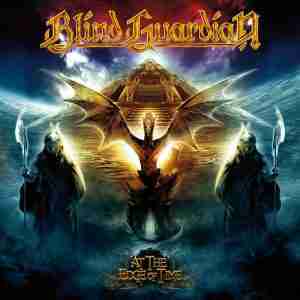 In general, At the Edge of Time is a lot more traditional power metal album with some notable exceptions. Except Blind Guardians usual strong vocals, guitar work, and a more mixed selection of homages to various fantasy media among the songs rather than a singular focus on Tolkien’s Legendarium. In this case there are songs homaging the works of Michael Moorcock [“Tanelorn (Into the Void”), A Song of Ice and Fire (“War of the Thrones”), and Wheel of Time (“Wheel of Time”).
In general, At the Edge of Time is a lot more traditional power metal album with some notable exceptions. Except Blind Guardians usual strong vocals, guitar work, and a more mixed selection of homages to various fantasy media among the songs rather than a singular focus on Tolkien’s Legendarium. In this case there are songs homaging the works of Michael Moorcock [“Tanelorn (Into the Void”), A Song of Ice and Fire (“War of the Thrones”), and Wheel of Time (“Wheel of Time”).
Oddly, I believe I have to bring special attention to the song “Curse my Name” which has a unique high pitched singing that separates it from the vast majority of heavy metal out there. It also has genuinely interesting subject matter with the execution of Charles I. Specifically, it’s based on The Tenure of Kings and Magistrates, a contemporary political tract written by John Milton (of Paradise Lost fame) that called for his execution.
I’m going to say that “War of Thrones” and “The Wheel of Time” are the two other standout tracks from the volume despite the fact it was meant to center on “A Voice in the Dark” that I just don’t find to be particularly memorable. I may be letting my love of fantasty influence my feelings but I love both tracks and listen to them repeatedly.
“War of Thrones” is a softer and more melodic ballad that talks about the fall of Westeros as the Others are coming to kill everyone while they’re fighting over the Iron Throne. It has a lot of wonderful winter imagery and is actually a pretty astute observation about the setting. It’s both beautiful as well as depressing.
“The Wheel of Time” by contrast almost feels like its own album that was compressed into a single nine minute track. It’s a big fantastic song with a lot of the folksy Medieval elements that was throughout Nightfall on Middle Earth. It tells the rough story of Rand al’Thor and how he’s going to be unable to escape his destiny of madness as well as conquering the world to face the Dark One. This is definitely the centerpiece of the album for me and could have been expanded to be its own Nightfall-esque work.
There’s a two-disc version of this album but I’ll be honest that you should probably not bother with the second disc. The orchestral versions of some songs aren’t really worth it while the demo for “Curse My Name” is the first thing I’ve ever heard of Blind Guardian that I’ve actually hated. They really improved on it for the main disc.
Listen to At the Edge of Time by Blind GuardianThe post REVIEW: At the Edge of Time by Blind Guardian appeared first on Grimdark Magazine.
REVIEW: House of the Dragon – Episode 4 ‘King of the Narrow Sea’
House of the Dragon E4 continues its excellent run as cracks continue to grow between King Viserys and those around him. His brother Daemon is back following the brutal defeat of the Crab King and with one problem out of the way, more seem to appear for the weary Viserys, much like the disease spreading across the king’s skin…
Those on dragon watch may be disappointed by the lack of winged creatures in House of the Dragon E4 but the show more than makes up for it with more Prince Daemon, more Princess Rhaenyra, and definitely more sex and nudity – dispelling claims that House of the Dragon was going to be a watered-down Game of Thrones spin-off. Last week saw Daemon drag half a body across a battlefield, guts spilling out for all to see: this week saw the rogue prince drag his niece on a tour of King’s Landing’s more interesting areas – including a brothel, much to the delight of the forever scheming Hand of the King, Otto Hightower. There is less blood and guts in House of the Dragon E4 but it still delivers another episode full of tension as the key players of the inevitable conflict are pulled into place. Viserys looks weaker every time we lay eyes on him and the folk of Flea Bottom are laughing at his decision to name a woman as heir just as he begins to realise just how ambitious his Hand has been since Viserys lost his wife in childbirth.
House of the Dragon E4 is all about relationships: those that are breaking down and those being strengthened. Viserys pushes both Otto and Daemon away just as his brother draws closer to Rhaenyra. Rhaenyra grows closer to Ser Cristan Cole as her friendship with Alicent (her friend, queen, stepmother, etc…) hangs together by a thread. We begin to see that perhaps the young Targaryen is freer than Alicent, who stands beside barred windows with her crying child before being called to the bedroom by her ill, and much older, husband. Life really can suck for the people of Westeros and Game of Thrones has always excelled when focusing on the way people can be trapped by the expectations of their position. It is always interesting to watch those who seemingly have power be weighed down by the crown on their head. Robert Baratheon. Ned Stark. Viserys. Alicent. Rhaenyra. All seem to have everything but it does not make them happier. The poor people of Flea Bottom appear happier even as one man is casually murdered in the streets with fire blasted out everywhere you look.
Less swords and bloody guts than last week; more flesh and awkward sex. House of the Dragon E4 places all the big players in positions where they can seethe and whisper an urge for vengeance. No one comes out of this episode well and it allows the audience a chance to breathe before the Fire and Blood comes flying in. Four episodes in, any doubts about whether this Game of Thrones prequel could deliver have surely been burnt to a crisp.
The post REVIEW: House of the Dragon – Episode 4 ‘King of the Narrow Sea’ appeared first on Grimdark Magazine.
REVIEW: House of the Dragon – Episode 3 ‘King of the Narrow Sea’
House of the Dragon E4 continues its excellent run as cracks continue to grow between King Viserys and those around him. His brother Daemon is back following the brutal defeat of the Crab King and with one problem out of the way, more seem to appear for the weary Viserys, much like the disease spreading across the king’s skin…
Those on dragon watch may be disappointed by the lack of winged creatures in House of the Dragon E4 but the show more than makes up for it with more Prince Daemon, more Princess Rhaenyra, and definitely more sex and nudity – dispelling claims that House of the Dragon was going to be a watered-down Game of Thrones spin-off. Last week saw Daemon drag half a body across a battlefield, guts spilling out for all to see: this week saw the rogue prince drag his niece on a tour of King’s Landing’s more interesting areas – including a brothel, much to the delight of the forever scheming Hand of the King, Otto Hightower. There is less blood and guts in House of the Dragon E4 but it still delivers another episode full of tension as the key players of the inevitable conflict are pulled into place. Viserys looks weaker every time we lay eyes on him and the folk of Flea Bottom are laughing at his decision to name a woman as heir just as he begins to realise just how ambitious his Hand has been since Viserys lost his wife in childbirth.
House of the Dragon E4 is all about relationships: those that are breaking down and those being strengthened. Viserys pushes both Otto and Daemon away just as his brother draws closer to Rhaenyra. Rhaenyra grows closer to Ser Cristan Cole as her friendship with Alicent (her friend, queen, stepmother, etc…) hangs together by a thread. We begin to see that perhaps the young Targaryen is freer than Alicent, who stands beside barred windows with her crying child before being called to the bedroom by her ill, and much older, husband. Life really can suck for the people of Westeros and Game of Thrones has always excelled when focusing on the way people can be trapped by the expectations of their position. It is always interesting to watch those who seemingly have power be weighed down by the crown on their head. Robert Baratheon. Ned Stark. Viserys. Alicent. Rhaenyra. All seem to have everything but it does not make them happier. The poor people of Flea Bottom appear happier even as one man is casually murdered in the streets with fire blasted out everywhere you look.
Less swords and bloody guts than last week; more flesh and awkward sex. House of the Dragon E4 places all the big players in positions where they can seethe and whisper an urge for vengeance. No one comes out of this episode well and it allows the audience a chance to breathe before the Fire and Blood comes flying in. Four episodes in, any doubts about whether this Game of Thrones prequel could deliver have surely been burnt to a crisp.
The post REVIEW: House of the Dragon – Episode 3 ‘King of the Narrow Sea’ appeared first on Grimdark Magazine.
September 12, 2022
REVIEW: A Book of Blades
If you need a fix of sword and sorcery action, look no further than A Book of Blades, the new short story anthology from the gang at Rogues in the House Podcast.
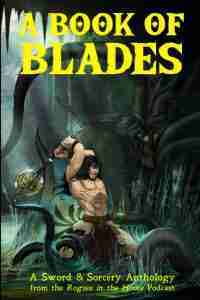 Rogues in the House is named after one of the original Conan the Barbarian stories, published by Robert E. Howard in 1934. Howard’s unequalled legacy in the sword and sorcery subgenre is vibrantly displayed in A Book of Blades, with fifteen stories contributed by sixteen authors.
Rogues in the House is named after one of the original Conan the Barbarian stories, published by Robert E. Howard in 1934. Howard’s unequalled legacy in the sword and sorcery subgenre is vibrantly displayed in A Book of Blades, with fifteen stories contributed by sixteen authors.
The list of authors includes established greats such as contemporary Conan author John C. Hocking, dark fantasy novelist John R. Fultz, and Howard Andrew Jones, author of The Chronicles of Sword and Sand series. A Book of Blades also features a bevy of emerging voices in the sword and sorcery subgenre.
A Book of Blades kicks off with “By the Sword,” John C. Hocking’s action-packed story of personal vengeance that will leave your heart racing. The mood darkens further in the next story, “Ghost Song” by Chuck Clark, which begins with a ghoulish scream and will prove to be a highlight for grimdark lovers.
One of my favorite stories in the anthology is “How They Fall” by Angeline B. Adams and Remco van Straten, the sole co-authored story in A Book of Blades. At only four pages, “How They Fall” is also the shortest story in the anthology, but these four pages pack a big emotional punch.
Another favorite is “Embracing Ember” by S.E. Lindberg, which is perhaps the most grimdark story in A Book of Blades. “Embracing Ember” connects to Lindberg’s Lords of Dyscrasia series and tells the story of a necromancer’s gore-filled struggles to raise his golem daughters.
I’d also like to mention “The City of the Screaming Pillars,” Cora Buhlert’s quest story of four travelers seeking long-lost treasure in an abandoned city in the middle of the desert. “The City of the Screaming Pillars” starts off as a standard quest story but then dives into much darker Lovecraftian territory.
As a special treat, the end of the book features a showcase of artwork from several artists, including Morgan King, director of the animated dark fantasy horror film, The Spine of the Night, and Sara Frazetta, granddaughter of the famed fantasy artist Frank Frazetta. Sara is also the founder of Frazetta Girls, a family initiative dedicated to maintaining the legacy of her pioneering grandfather.
A Book of Blades is a romp for sword and sorcery fans, a delightful mélange of classic quests, fast-paced action, weird horror, and even a touch of humor.
4.5/5
Read A Book of BladesThe post REVIEW: A Book of Blades appeared first on Grimdark Magazine.
September 11, 2022
REVIEW: The Children of Gods and Fighting Men by Shauna Lawless
The Children of Gods and Fighting Men is the debut novel of Shauna Lawless. It is a thoroughly amazing historical fantasy from Ad Astra, the Science Fiction and Fantasy imprint of Head of Zeus. This was one of my most anticipated releases of the year and I am so pleased to be able to read it and provide a review for Grimdark Magazine.
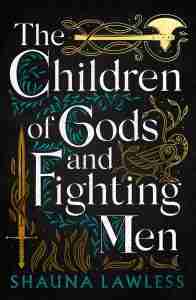 This really is a fantastic novel and as debut I think Lawless has knocked it out of the park. I would put The Children of Gods and Fighting Men as one of my favourite books of the year because everything about it is done well. Lawless has seamlessly woven Irish mythology and history together and created a well-structured and paced novel which can be enjoyed if you know nothing about the history or folk lore of Ireland but, if you do, her attention to historical detail and accuracy adds to the pleasure of reading The Children of Gods and Fighting Men. If also (like me) you are a reader who will mispronounce words in your mind, Lawless has also provided a very handy glossary at the start of the novel showing the kingdoms of all the characters and their name pronunciations.
This really is a fantastic novel and as debut I think Lawless has knocked it out of the park. I would put The Children of Gods and Fighting Men as one of my favourite books of the year because everything about it is done well. Lawless has seamlessly woven Irish mythology and history together and created a well-structured and paced novel which can be enjoyed if you know nothing about the history or folk lore of Ireland but, if you do, her attention to historical detail and accuracy adds to the pleasure of reading The Children of Gods and Fighting Men. If also (like me) you are a reader who will mispronounce words in your mind, Lawless has also provided a very handy glossary at the start of the novel showing the kingdoms of all the characters and their name pronunciations.
The fantasy elements of The Children of Gods and Fighting Men are low magic, and use the Irish legends of the Fomorians, hostile supernatural beings, and their rivals the Descendants of the Tuatha Dé Danann. These factions are represented through the two narrative perspectives in the novel. Firstly Gormflaith, the widow of the King of Dublin and one of the last of the Fomorians, and Fódla, a Descendent with the power to heal. Through these two female voices Lawless has shown the novel in a unique way. There are no clear cut good or bad sides, and as women in medieval society neither Gormflaith nor Fódla hold power in their own rights. Though Gormflaith has the brains and political acumen to rival Cersei Lannister for maternal ambition and she holds a relatively high position in Dublin society, she frustratingly has to persuade and cajole those around her to try and further her plans. Fódla is less cunning and struggles with her enforced role as a spy on the humans. Both women though are very engaging and relatable. The other character are compelling and well written, even if they are not the main focuses of the novel.
The moral greyness of the characters in The Children of Gods and Fighting Men will absolutely appeal to fans of grimdark. The physical violence is less directly gritty or visceral than fantasy novels set in a similar era but this is absolutely down to the fact that the narrative perspectives are removed from those events. Lawless does not shy away from the violent realities of a tenth century world, but her main characters will either be watching from a distance or dealing with the aftermath of much of the bloody altercations. I would say also that due to the seldom seen nature of the magic in The Children of Gods and Fighting Men that it is definitely more a historical fantasy than a fantastical history. Personally, I loved these elements and the restrained way the plot moves forward emphasised the frustration the main characters must feel as they navigate (or are navigated) through nearly two decades of events. It may not be a fast-paced action packed novel, but this is beautifully written and totally captivating. I wish I had been able to sit and read it in one go.
I am so glad that The Children of Gods and Fighting Men is the first in a trilogy because I really do want to read more from Lawless and this world. There was no palpitation inducing cliff hanger but the set is laid for the next novel and I am very excited to read where Lawless will take the story next. The second instalment in the Gael Song trilogy is The Words of Kings and Prophets and is slated for release in late 2023 which gives me plenty of time to indulge in a reread or two. A massive ‘thank you’ to the team at Ad Astra / Head of Zeus and Shauna Lawless for sending it over.
5/5
Read The Children of Gods and Fighting Men by Shauna LawlessThe post REVIEW: The Children of Gods and Fighting Men by Shauna Lawless appeared first on Grimdark Magazine.
REVIEW: The Red Scholar’s Wake by Aliette de Bodard
Aliette de Bodard’s The Red Scholar’s Wake was one of my most anticipated novels of 2022 and it did not disappoint. Inspired by the author’s Vietnamese heritage, this is the story of an arranged marriage between Xich Si, bot maker, data analyst, mother and scavenger and Rice Fish, sentient ship and space pirate leader. Part sapphic romance, part space opera, with mature characters in the prime of their lives – no twenty-year-olds finding their feet here – and all gorgeous prose. Aliette de Bodard is one of the strongest writers in SFF working today – her novella, Fireheart Tiger was just up for a Hugo last week and this is up on the same level in terms of writing and general craft.
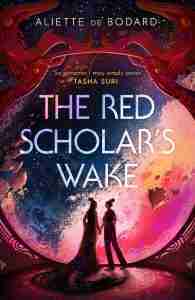 When Rice Fish captures Xich Si’s ship, the latter expects to be tortured to death – or at the very least, an unpleasant imprisonment. So, when Rice Fish proposes a marriage alliance as the inciting incident of The Red Scholar’s Wake, Xich Si is taken aback, especially since Rice Fish, sentient ship, is famously married to the Red Scholar. Except, the Red Scholar has just died under mysterious circumstances, and this new alliance would be mutually beneficial, protecting them both and allowing Rice Fish to investigate her wife’s death. And of course, over the remainder of the story, they do, in fact, fall in love. But this isn’t a cheesy romance. This is a science fiction story that happens to have romantic elements. (Side note: with the amount of times I’m typing the words “rice” and “fish” and the context of Aliette’s Vietnamese heritage, I REALLY want some Vietnamese food now. Give me that fish sauce on rice.)
When Rice Fish captures Xich Si’s ship, the latter expects to be tortured to death – or at the very least, an unpleasant imprisonment. So, when Rice Fish proposes a marriage alliance as the inciting incident of The Red Scholar’s Wake, Xich Si is taken aback, especially since Rice Fish, sentient ship, is famously married to the Red Scholar. Except, the Red Scholar has just died under mysterious circumstances, and this new alliance would be mutually beneficial, protecting them both and allowing Rice Fish to investigate her wife’s death. And of course, over the remainder of the story, they do, in fact, fall in love. But this isn’t a cheesy romance. This is a science fiction story that happens to have romantic elements. (Side note: with the amount of times I’m typing the words “rice” and “fish” and the context of Aliette’s Vietnamese heritage, I REALLY want some Vietnamese food now. Give me that fish sauce on rice.)
What made this truly stand out to me was Aliette’s writing. As mentioned above, Aliette’s prose is outstanding. It is descriptive and evocative without being overwrought, it is witty and full of emotion. Every character, every scene comes to life immediately and plastically, drawing the reader into this world of space pirates, family biological and found and relationships of all sorts. It is at times delicate, and at other times matter of fact and then again it will make you laugh out loud with dry wit. The characters’ maturity makes them stand out in a market saturated with coming-of-age stories across young adult and adult publishing, and it is a true breath of fresh air to read about protagonists coming into their story after a life well-lived, with attachments and history, knowing who they are and what they want. I could not recommend The Red Scholar’s Wake more.
Read The Red Scholar’s Wake by Aliette de BodardThe post REVIEW: The Red Scholar’s Wake by Aliette de Bodard appeared first on Grimdark Magazine.
September 10, 2022
REVIEW: Cowboy Bebop: Supernova Swing
Cowboy Bebop is widely regarded as one of the most influential anime series of all time, a classic with an almost universal reputation for quality that is beloved by a staggeringly large audience, which is remarkable how divisive the anime fandom has a tendency to be. Regardless of any other tastes and inclinations, practically all fans of anime can agree: Cowboy Bebop is top tier. The new graphic novel released by Titan, Cowboy Bebop: Supernova Swing managed to capture the tone and style of the original show and tell an all new tale that is fun, engrossing, and should more than satisfy fans of the anime.
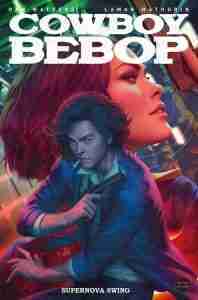 Penned by Dan Watters and drawn by Lamar Mathurin, Cowboy Bebop: Supernova Swing tells a stylish, action-heavy, moody story that while aesthetically different from the original anime, is dead accurate tonally. The bulk of that accuracy lies with Watters and his ability to comfortably replicate the voices of the characters from the original series. Spike Spiegel reads like Spike, Faye and Jet “sound” like they’re supposed to. But I’d be remiss if I didn’t mention the kinetic, dynamic compositions created by Mathurin in their page layouts and action sequences that are a lot of fun and guide the reader around the page at a solid clip. The colorists here are also integral (much as they are with any comic), with the tones and textures created by Roman Titov and Emilio Lecce really driving home the visual connection to the animated version of Cowboy Bebop.
Penned by Dan Watters and drawn by Lamar Mathurin, Cowboy Bebop: Supernova Swing tells a stylish, action-heavy, moody story that while aesthetically different from the original anime, is dead accurate tonally. The bulk of that accuracy lies with Watters and his ability to comfortably replicate the voices of the characters from the original series. Spike Spiegel reads like Spike, Faye and Jet “sound” like they’re supposed to. But I’d be remiss if I didn’t mention the kinetic, dynamic compositions created by Mathurin in their page layouts and action sequences that are a lot of fun and guide the reader around the page at a solid clip. The colorists here are also integral (much as they are with any comic), with the tones and textures created by Roman Titov and Emilio Lecce really driving home the visual connection to the animated version of Cowboy Bebop.
The story that unfolds across the pages of Cowboy Bebop: Supernova Swing reads like something that could have been an animated episode and pays equal service to levity and seriousness, Watters deftly employing the acerbic wit of the Bebop’s crew to create truly humorous moments that are balanced by more quiet, pensive moments that creep close to tragedy. It goes a long way towards replicating the feel of the show, and creates an immersive experience that ultimately pays off in its believability.
For readers who have never experienced Cowboy Bebop: Supernova Swing is a fun, rollicking space caper jam packed with interesting characters and edge of your seat action that’s sure to satisfy. But if you are a fan of the original, I think there’s something truly special here, something that opens up the fascinating world and tells a whole new story in it that is just as captivating and worth investing in. Cowboy Bebop: Supernova Swing is a fantastic story for old fans and newcomers alike, a solid four stars that left me very much wanting more.
See you, space cowboy.
Read Cowboy Bebop: Supernova SwingThe post REVIEW: Cowboy Bebop: Supernova Swing appeared first on Grimdark Magazine.
REVIEW: Heart of the Sun Warrior by Sue Lynn Tan
Heart of the Sun Warrior is the second book in Sue Lynn Tan’s Celestial Kingdom duology, following up on The Daughter of the Moon Goddess (see our review of the first book here). This follows Xingyin’s story a time after the events of the first book, and has quite a different feel to it. Where The Daughter of the Moon Goddess was focused on Xingyin growing up, maturing and finding out who she is as a person, wrapped in a quest story, this second part of the story is far less plot-driven and more concerned with politics and relationships than quests. Xingyin, as the daughter of a goddess, comes with inherent longevity, so this does continue the personal growth arc and she matures further, which I appreciated in many ways.
 Where I think Heart of the Sun Warrior may lose a lot of readers who come to read reviews on Grimdark Magazine – from the subset who may have picked it up in the first place – is that, even more than The Daughter of the Moon Goddess, this utilises the YA trope of the love triangle. Now, that in itself is not a bad thing, and I found that the way it was implemented here was very well done, especially how it ultimately resolved. But even more than the first in the duology, this is a clear crossover novel, and one that I feel will not resonate as much with readers of Grimdark. While there is still extensive betrayal and moral quandry, much of it is ultimately solved by mature consideration, or, in some parts, melodrama. And while that made me enjoy my reading experience, it is far more wholesome than what we usually report on here.
Where I think Heart of the Sun Warrior may lose a lot of readers who come to read reviews on Grimdark Magazine – from the subset who may have picked it up in the first place – is that, even more than The Daughter of the Moon Goddess, this utilises the YA trope of the love triangle. Now, that in itself is not a bad thing, and I found that the way it was implemented here was very well done, especially how it ultimately resolved. But even more than the first in the duology, this is a clear crossover novel, and one that I feel will not resonate as much with readers of Grimdark. While there is still extensive betrayal and moral quandry, much of it is ultimately solved by mature consideration, or, in some parts, melodrama. And while that made me enjoy my reading experience, it is far more wholesome than what we usually report on here.
Personally, I found Heart of the Sun Warrior a quick and entertaining read, compelling and lyrical. As The Daughter of the Moon Goddess, it is steeped in Chinese mythology, and packaged in a gorgeously designed book, both on the outside with a beautiful cover and on the inside with careful design and thoughtful details. And Harper Voyager makes the most stunning ARCs in the industry as well, so I can’t stop staring at the beautiful object. The writing itself matches that. Descriptive and emotive, with a strong focus on evoking atmosphere and distinctive characters, these books are great reads for anyone who likes books steeped in mythology, heroines determined to put themselves and their own development first and a good dose of balancing political needs. I did find the pacing was a bit slow at times, leading to tension dropping off a bit – I think the story could have done with a bit of a trim around the edges, but it was a very solid four star read for me. I know I’ll be rereading the duology again and again, as for me, these are just lovely books that hit the right spots.
Read Heart of the Sun Warrior by Sue Lynn TanThe post REVIEW: Heart of the Sun Warrior by Sue Lynn Tan appeared first on Grimdark Magazine.
September 9, 2022
REVIEW: Witness for the Dead by Katherine Addison
Witness for the Dead by Katherine Addison is set in the same world as The Goblin Emperor but follows spirit medium, Thara Celehar, as he is appointed to the city of Amalo. Amalo is, bluntly, a pit and he receives no support from the local church in his endeavors when he’s not being outright vilified by the locals. I was a huge fan of The Goblin Emperor and, I admit, I was a bit disappointed to discover that there would be a new protagonist for the series. Still, I was bound and determined to give the book a shot.
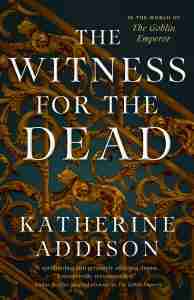 Our protagonist has numerous jobs that he follows up on throughout the book with this providing the books’ primary narrative. The closest plot to a central story is his investigation of the murder of an opera singer known for her gold digging as well as manipulative ways. The problem is not that there’s no suspects, it’s that there’s dozens of suspects as virtually everyone who knew her wanted to kill her.
Our protagonist has numerous jobs that he follows up on throughout the book with this providing the books’ primary narrative. The closest plot to a central story is his investigation of the murder of an opera singer known for her gold digging as well as manipulative ways. The problem is not that there’s no suspects, it’s that there’s dozens of suspects as virtually everyone who knew her wanted to kill her.
There are also other supporting plots that interweave through the main narrative but never truly tie in because they’re fundamentally a sign of how busy and intrigue-ridden the city is. A man fakes a will naming him as the heir of the family fortune and when his father’s ghost is consulted, simply calls fraud on Celehar before forcing the man to prove his credentials. Celehar is forced to journey to a distant rural village in order to deal with a cannibalistic ghoul. Celehar even undergoes a trial by ordeal on a magical haunted mountain.
If there’s any flaws with Witness for the Dead, it’s very much a procedural storyline and the fact Celehar doesn’t really any sort of arc. Like Columbo or Hercule Poroit, he’s pretty much the same person at the beginning of the story that he is at the end. This is a contrast to Maia in The Goblin Emperor as he transforms from a meek insecure abused victim into someone who wishes to transform the Empire through will alone.
Much of the appeal of the books is the fact that we get a truly vivid picture of the city of Amalo. It is a gritty place somewhere between high fantasy and steampunk with a Dishonored-esque feel. However, it’s also a place where Celehar comes across a little too stoic as well as emotionless. I feel like the story might have benefited from giving him a bit more passion or feeling regarding the events in his life. Given his tragic romantic past established in The Goblin Emperor, it’s kind of sad that he also is only ever mildly annoyed with most people.
Despite this, I’m going to give Witness for the Dead a 4 star rating out of 5. It’s a good book, well-written, and is scarily good at its world-building.
Read The Witness for the Dead by Katherine AddisonThe post REVIEW: Witness for the Dead by Katherine Addison appeared first on Grimdark Magazine.
Ten Queer Books to Kickstart Your Reading
Welcome to the top ten queer books to kickstart your reading. There is a notion that books that appeal to a Grimdark reading audience are written by cis-het white men for cis-het white men. But within the wider Grimdark area, especially when taking into consideration darker genre titles that have appeal to our audience, there is so much more than that. In my time writing for Grimdark Magazine, I have had the pleasure of reading and reviewing a range of queer and diverse books, and here are some of the books that have stood out most to me in the last few years.
Sistersong by Lucy Holland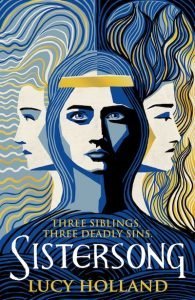 In Sistersong, Lucy Holland takes a folk ballad of three sisters, and turns it into a story of three siblings, set in post-Roman Britain. Born three girls, the oldest, Keyne, grows up to realise that he is a man rather than a woman. Holland tells this story with nuance and care, in a period before being queer, before having the words to express this were a thing. Holland’s version of Merlin in this tale is gender fluid, appearing as both man and woman, depending on company and circumstance, which gave me so much queer joy as well – I loved her lyrical writing, the unique story and how it was rooted in a traditional ballad, and these queer elements just made me fall for it even more. Read our full review here (and if you buy a paperback in the UK you may even spot a quote from it!)
In Sistersong, Lucy Holland takes a folk ballad of three sisters, and turns it into a story of three siblings, set in post-Roman Britain. Born three girls, the oldest, Keyne, grows up to realise that he is a man rather than a woman. Holland tells this story with nuance and care, in a period before being queer, before having the words to express this were a thing. Holland’s version of Merlin in this tale is gender fluid, appearing as both man and woman, depending on company and circumstance, which gave me so much queer joy as well – I loved her lyrical writing, the unique story and how it was rooted in a traditional ballad, and these queer elements just made me fall for it even more. Read our full review here (and if you buy a paperback in the UK you may even spot a quote from it!)
King Cador’s children inherit a land abandoned by the Romans, torn by warring tribes. Riva can cure others, but can’t heal her own scars. Keyne battles to be seen as the king’s son, although born a daughter. And Sinne dreams of love, longing for adventure.
All three fear a life of confinement within the walls of the hold, their people’s last bastion of strength against the invading Saxons. However, change comes on the day ash falls from the sky – bringing Myrdhin, meddler and magician. The siblings discover the power that lies within them and the land. But fate also brings Tristan, a warrior whose secrets will tear them apart.
Riva, Keyne and Sinne become entangled in a web of treachery and heartbreak, and must fight to forge their own paths. It’s a story that will shape the destiny of Britain.
Read Sistersong by Lucy HollandLight From Uncommon Stars by Ryka Aoki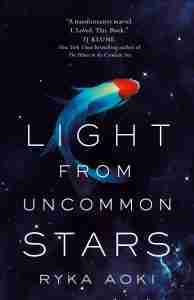 Ryka Aoki’s Light From Uncommon Stars is both an extremely dark and a highly uplifting book. Its main character, Katrina, is a trans woman who has suffered through abuse and transphobia – and has now found a home with Shizuka Satomi, a famous violinist. Except, Shizuka has made a deal with the devil which includes Katrina’s soul. While Katrina finally starts to feel like she has escaped her cycle of abuse as she transforms into a brilliant violinist, Shizuka falls in love with a retired starship captain turned donut shop owner, Lan Tran. But the devil is still waiting to collect Katrina’s soul. This is the sort of book to rip your heart to shreds and make you cry in public (if you still have enough of a heart left after reading all of that Grimdark) – it’s not quite a Grimdark book, but it has lots to appeal to a Grimdark audience with complex characters and the constant feeling of dread hanging over the story.
Ryka Aoki’s Light From Uncommon Stars is both an extremely dark and a highly uplifting book. Its main character, Katrina, is a trans woman who has suffered through abuse and transphobia – and has now found a home with Shizuka Satomi, a famous violinist. Except, Shizuka has made a deal with the devil which includes Katrina’s soul. While Katrina finally starts to feel like she has escaped her cycle of abuse as she transforms into a brilliant violinist, Shizuka falls in love with a retired starship captain turned donut shop owner, Lan Tran. But the devil is still waiting to collect Katrina’s soul. This is the sort of book to rip your heart to shreds and make you cry in public (if you still have enough of a heart left after reading all of that Grimdark) – it’s not quite a Grimdark book, but it has lots to appeal to a Grimdark audience with complex characters and the constant feeling of dread hanging over the story.
Shizuka Satomi made a deal with the devil: To escape damnation, she must entice seven other violin prodigies to trade their souls for success. She has already delivered six.
When Katrina Nguyen, a young transgender runaway, catches Shizuka’s ear with her wild talent, Shizuka can almost feel the curse lifting. She’s found her final candidate.
But in a donut shop off a bustling highway in the San Gabriel Valley, Shizuka meets Lan Tran, retired starship captain, interstellar refugee, and mother of four. Shizuka doesn’t have time for crushes or coffee dates, what with her very soul on the line, but Lan’s kind smile and eyes like stars might just redefine a soul’s worth. And maybe something as small as a warm donut is powerful enough to break a curse as vast as the California coastline.
As the lives of these three women become entangled by chance and fate, a story of magic, identity, curses, and hope begins, and a family worth crossing the universe for is found.
Read Light From Uncommon Stars by Ryka AokiA Dowry of Blood by S.T. Gibson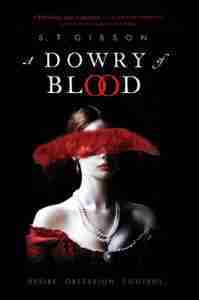 S.T. Gibson’s A Dowry of Blood is one of the queerest books in our wheelhouse. A dark, polyamorous retelling of the Brides of Dracula featuring an assortment of queer vampires loving and rampaging over the span of centuries across Europe, this is a twisted tale perfect for lovers of Grimdark with a dash of romance. Originally self-published, it has been picked up by Orbit to be re-released in October 2022 with a new cover and including a sequel short story. Read our full review here.
S.T. Gibson’s A Dowry of Blood is one of the queerest books in our wheelhouse. A dark, polyamorous retelling of the Brides of Dracula featuring an assortment of queer vampires loving and rampaging over the span of centuries across Europe, this is a twisted tale perfect for lovers of Grimdark with a dash of romance. Originally self-published, it has been picked up by Orbit to be re-released in October 2022 with a new cover and including a sequel short story. Read our full review here.
Saved from the brink of death by a mysterious stranger, Constanta is transformed from a medieval peasant into a bride fit for an undying king. But when Dracula draws a cunning aristocrat and a starving artist into his web of passion and deceit, Constanta realizes that her beloved is capable of terrible things.
Finding comfort in the arms of her rival consorts, she begins to unravel their husband’s dark secrets. With the lives of everyone she loves on the line, Constanta will have to choose between her own freedom and her love for her husband. But bonds forged by blood can only be broken by death.
Read A Dowry of Blood by S.T. GibsonBluebird by Ciel Pierlot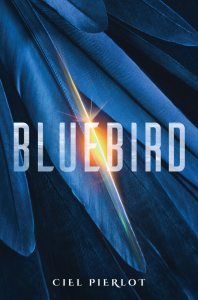 Lesbian Gunslingers in Space? That is a tagline that sells books. The book in question is Ciel Pierlot’s Bluebird, space opera full of dry humour and sparse wit. There are resistance fighters, big-scale politics and a badass librarian girlfriend, ingredients ideal to make this both a great read for the Grimdark Magazine audience and one of the best space operas I’ve read. See the full review here.
Lesbian Gunslingers in Space? That is a tagline that sells books. The book in question is Ciel Pierlot’s Bluebird, space opera full of dry humour and sparse wit. There are resistance fighters, big-scale politics and a badass librarian girlfriend, ingredients ideal to make this both a great read for the Grimdark Magazine audience and one of the best space operas I’ve read. See the full review here.
Three factions vie for control of the galaxy. Rig, a gunslinging, thieving rebel-with-a-cause, doesn’t give a damn about them, and she hasn’t looked back since abandoning them three years ago. That is, until her former faction sends her a message: Return what she stole from them, or her twin sister will die.
Rig embarks on a journey across the galaxy to save her – but for once, she’s not alone. She has help from her network of resistance contacts, her taser-wielding librarian girlfriend, and a mysterious bounty hunter.
If Rig fails, trillions of lives will be lost – including her sister’s. But if she succeeds, she might just pull the whole damn system down around their ears. Either way, she’s going to do it with Panache and Pizzazz.
Read Bluebird by Ciel PierlotSpear by Nicola Griffith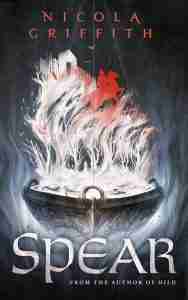 Nicola Griffith’s Spear is one of my all-time favourite books. A short novella telling an epic story in miniature, Spear’s only major flaw is that there isn’t more of it. Not because it needs it, but because Griffith’s writing and characters will leave you wanting more. The story plays with gender in interesting ways – while Peretur, the main character, based on the archetype more commonly known as Percival, herself doesn’t question her femininity, other’s perception of her differs based on their own preconceived notions and cultural expectations. Griffith understands the nature of gender as a social construct, and goes on to use it as a plot device, rather than having her main character cross-dress on purpose. And that is one of the things that made Spear stand out to me in terms of queer representation. It helps that there is a brilliantly depicted, tender, sapphic relationship at its core, too. Read our full review here.
Nicola Griffith’s Spear is one of my all-time favourite books. A short novella telling an epic story in miniature, Spear’s only major flaw is that there isn’t more of it. Not because it needs it, but because Griffith’s writing and characters will leave you wanting more. The story plays with gender in interesting ways – while Peretur, the main character, based on the archetype more commonly known as Percival, herself doesn’t question her femininity, other’s perception of her differs based on their own preconceived notions and cultural expectations. Griffith understands the nature of gender as a social construct, and goes on to use it as a plot device, rather than having her main character cross-dress on purpose. And that is one of the things that made Spear stand out to me in terms of queer representation. It helps that there is a brilliantly depicted, tender, sapphic relationship at its core, too. Read our full review here.
The girl knows she has a destiny before she even knows her name. She grows up in the wild, in a cave with her mother, but visions of a faraway lake come to her on the spring breeze, and when she hears a traveler speak of Artos, king of Caer Leon, she knows that her future lies at his court.
And so, brimming with magic and eager to test her strength, she breaks her covenant with her mother and, with a broken hunting spear and mended armour, rides on a bony gelding to Caer Leon. On her adventures, she will meet great knights and steal the hearts of beautiful women. She will fight warriors and sorcerers. And she will find her love, and the lake, and her fate.
Read Spear by Nicola GriffithSummer Sons by Lee Mandelo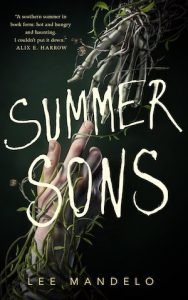 One book that can’t be missed out is Lee Mandelo’s Summer Sons. Written by a non-binary author, this features the most oblivious main character realising that, actually, he may not be straight after all, and the best trans housemate. Summer Sons is all Southern Gothic, vibes over plot, with stellar characters and tension so thick you could cut it with a knife. See our full review here.
One book that can’t be missed out is Lee Mandelo’s Summer Sons. Written by a non-binary author, this features the most oblivious main character realising that, actually, he may not be straight after all, and the best trans housemate. Summer Sons is all Southern Gothic, vibes over plot, with stellar characters and tension so thick you could cut it with a knife. See our full review here.
Andrew and Eddie did everything together, best friends bonded more deeply than brothers, until Eddie left Andrew behind to start his graduate program at Vanderbilt. Six months later, only days before Andrew was to join him in Nashville, Eddie dies of an apparent suicide. He leaves Andrew a horrible inheritance: a roommate he doesn’t know, friends he never asked for, and a gruesome phantom that hungers for him.
As Andrew searches for the truth of Eddie’s death, he uncovers the lies and secrets left behind by the person he trusted most, discovering a family history soaked in blood and death. Whirling between the backstabbing academic world where Eddie spent his days and the circle of hot boys, fast cars, and hard drugs that ruled Eddie’s nights, the walls Andrew has built against the world begin to crumble, letting in the phantom that hungers to possess him.
Read Summer Sons by Lee MandeloA Master of Djinn by P. Djèlí Clark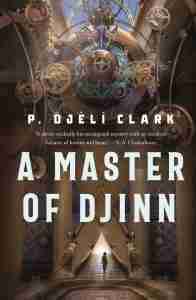 P. Djèlí Clark’s A Master of Djinn was one of the finalists for the 2022 Hugos. The first full-length novel to feature his character of Fatma el-Sha’arawi, Muslim, gay, badass detective in Cairo in 1912. She had prior appearances in short fiction and novellas, but this is both Djèlí Clark’s novel debut and her first outing in a longer work – someone is murdering members of a secret brotherhood, and Fatma is on the case. But to me, the plot isn’t at the centre of this story. This is a great commercial novel, but one that will give you as much as you’re willing to put in. There is so much to be drawn out of A Master of Djinn in terms of worldbuilding, in terms of critical views on colonialism, perspectives that are still relevant in the present day. And Fatma and her girlfriend Siti are one of my favourite sapphic couples.
P. Djèlí Clark’s A Master of Djinn was one of the finalists for the 2022 Hugos. The first full-length novel to feature his character of Fatma el-Sha’arawi, Muslim, gay, badass detective in Cairo in 1912. She had prior appearances in short fiction and novellas, but this is both Djèlí Clark’s novel debut and her first outing in a longer work – someone is murdering members of a secret brotherhood, and Fatma is on the case. But to me, the plot isn’t at the centre of this story. This is a great commercial novel, but one that will give you as much as you’re willing to put in. There is so much to be drawn out of A Master of Djinn in terms of worldbuilding, in terms of critical views on colonialism, perspectives that are still relevant in the present day. And Fatma and her girlfriend Siti are one of my favourite sapphic couples.
Cairo, 1912: though Fatma el-Sha’arawi is the youngest woman working for the Ministry of Alchemy, Enchantments and Supernatural Entities, she’s certainly not a rookie, especially after preventing the destruction of the universe last summer.
So when someone murders a secret brotherhood dedicated to one of the most famous men in history, Al-Jahiz, Agent Fatma is called onto the case. Al-Jahiz transformed the world 50 years ago when he opened up the veil between the magical and mundane realms, before vanishing into the unknown. This murderer claims to be Al-Jahiz, returned to condemn the modern age for its social oppressions. His dangerous magical abilities instigate unrest in the streets of Cairo that threaten to spill over onto the global stage.
Alongside her Ministry colleagues and a familiar person from her past, Agent Fatma must unravel the mystery behind this imposter to restore peace to the city—or face the possibility he could be exactly who he seems…
Read A Master of Djinn by P. Djèlí ClarkThe Unbroken by C.L. Clark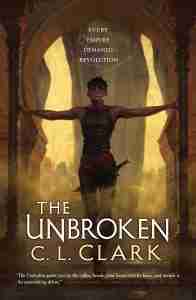 2021 was the year of the sapphic trifecta – The Jasmine Throne by Tasha Suri, She Who Became the Sun by Shelley Parker-Chan and The Unbroken by C.L. Clark. All three excellent books, but the one that I’d like to highlight for you here is The Unbroken. This is modern Grimdark at its finest. Epic in scale, set in a world fraught with discord at all fronts and centred around Touraine, a soldier compelled to fight for the conquering army of her home, and Luca, the conquering princess (though she ain’t very princessy). If old-school Grimdark – fucked up world, fucked up people, fucked up morals – is what brought you to this site, then The Unbroken is the sort of book you should strongly consider picking up from the up and coming generation of writers. And hey, Touraine’s arms are quite something to look at too.
2021 was the year of the sapphic trifecta – The Jasmine Throne by Tasha Suri, She Who Became the Sun by Shelley Parker-Chan and The Unbroken by C.L. Clark. All three excellent books, but the one that I’d like to highlight for you here is The Unbroken. This is modern Grimdark at its finest. Epic in scale, set in a world fraught with discord at all fronts and centred around Touraine, a soldier compelled to fight for the conquering army of her home, and Luca, the conquering princess (though she ain’t very princessy). If old-school Grimdark – fucked up world, fucked up people, fucked up morals – is what brought you to this site, then The Unbroken is the sort of book you should strongly consider picking up from the up and coming generation of writers. And hey, Touraine’s arms are quite something to look at too.
Touraine is a soldier. Stolen as a child and raised to kill and die for the empire, her only loyalty is to her fellow conscripts. But now, her company has been sent back to her homeland to stop a rebellion and the ties of blood may be stronger than she thought.
Luca needs a turncoat. Someone desperate enough to tiptoe the bayonet’s edge between treason and orders. Someone who can sway the rebels toward peace, while Luca focuses on what really matters: getting her uncle off her throne.
Through assassinations and massacres, in bedrooms and war rooms, Touraine and Luca will haggle over the price of a nation. But some things aren’t for sale.
Read The Unbroken by C.L. ClarkThe Priory of the Orange Tree by Samantha Shannon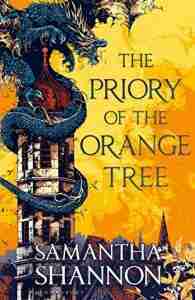 Before we had the sapphic trifecta, we had another big yellow queer fantasy: Samantha Shannon’s The Priory of the Orange Tree. A giant tome of an epic fantasy, this tells the story of a period in the queendom of Inys – complete with dragons, lesbian romance and a narrative crafted like a tapestry. This is a standalone where every thread gets woven into the plot, with nothing being there just for show but furthering the narrative and being part of the conclusion. I loved it – and there’s going to be another standalone (a prequel of sorts) set in the same world! I for one am hyped. See our full review of The Priory of the Orange Tree here.
Before we had the sapphic trifecta, we had another big yellow queer fantasy: Samantha Shannon’s The Priory of the Orange Tree. A giant tome of an epic fantasy, this tells the story of a period in the queendom of Inys – complete with dragons, lesbian romance and a narrative crafted like a tapestry. This is a standalone where every thread gets woven into the plot, with nothing being there just for show but furthering the narrative and being part of the conclusion. I loved it – and there’s going to be another standalone (a prequel of sorts) set in the same world! I for one am hyped. See our full review of The Priory of the Orange Tree here.
A world divided.
A queendom without an heir.
An ancient enemy awakens.
The House of Berethnet has ruled Inys for a thousand years. Still unwed, Queen Sabran the Ninth must conceive a daughter to protect her realm from destruction – but assassins are getting closer to her door.
Ead Duryan is an outsider at court. Though she has risen to the position of lady-in-waiting, she is loyal to a hidden society of mages. Ead keeps a watchful eye on Sabran, secretly protecting her with forbidden magic.
Across the dark sea, Tané has trained to be a dragonrider since she was a child but is forced to make a choice that could see her life unravel. Meanwhile, the divided East and West refuse to parley, and forces of chaos are rising from their sleep.
Read The Priory of the Orange Tree by Samantha ShannonGideon the Ninth by Tamsyn Muir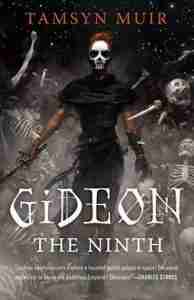 No list of queer books would be complete without Tamsyn Muir’s Gideon the Ninth. Famously known for the tag line ‘lesbian necromancers in space’, this is one of dark SFF’s biggest hitters in recent years. It is wacky, hilarious and the sequels get increasingly more confusing. But Tamsyn Muir gets to confuse me any day with books this good. If you haven’t experienced the chaos yet, the premise of Gideon the Ninth is basically a locked room murder mystery in a Gothic mansion floating in space – revolving around Gideon Nav, a himbo lesbian. Check out our reviews of Gideon the Ninth, Harrow the Ninth and Nona the Ninth here.
No list of queer books would be complete without Tamsyn Muir’s Gideon the Ninth. Famously known for the tag line ‘lesbian necromancers in space’, this is one of dark SFF’s biggest hitters in recent years. It is wacky, hilarious and the sequels get increasingly more confusing. But Tamsyn Muir gets to confuse me any day with books this good. If you haven’t experienced the chaos yet, the premise of Gideon the Ninth is basically a locked room murder mystery in a Gothic mansion floating in space – revolving around Gideon Nav, a himbo lesbian. Check out our reviews of Gideon the Ninth, Harrow the Ninth and Nona the Ninth here.
The Emperor needs necromancers.
The Ninth Necromancer needs a swordswoman.
Gideon has a sword, some dirty magazines, and no more time for undead nonsense.
Tamsyn Muir’s Gideon the Ninth unveils a solar system of swordplay, cut-throat politics, and lesbian necromancers. Her characters leap out of the audio, as skillfully animated as arcane revenants. The result is a heart-pounding epic science fantasy.
Brought up by unfriendly, ossifying nuns, ancient retainers, and countless skeletons, Gideon is ready to abandon a life of servitude and an afterlife as a reanimated corpse. She packs up her sword, her shoes, and her dirty magazines, and prepares to launch her daring escape. But her childhood nemesis won’t set her free without a service.
Harrowhark Nonagesimus, Reverend Daughter of the Ninth House and bone witch extraordinaire, has been summoned into action. The Emperor has invited the heirs to each of his loyal Houses to a deadly trial of wits and skill. If Harrowhark succeeds she will be become an immortal, all-powerful servant of the Resurrection, but no necromancer can ascend without their cavalier. Without Gideon’s sword, Harrow will fail, and the Ninth House will die.
Of course, some things are better left dead.
Read Gideon the Ninth by Tamsyn MuirThe post Ten Queer Books to Kickstart Your Reading appeared first on Grimdark Magazine.



